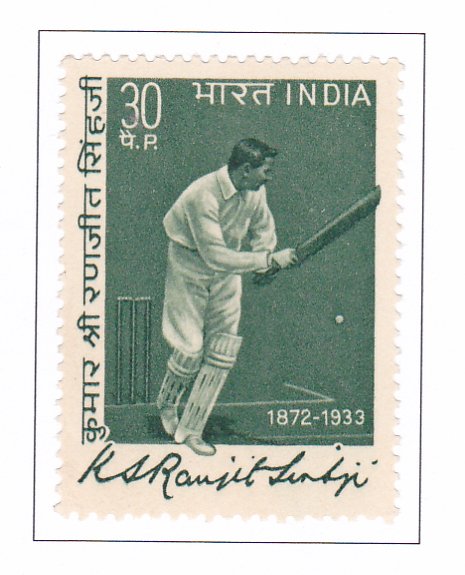Ranjit Sinh Ji 1872-1933

Technical Data
| Stamp Set | Personality Series |
|---|---|
| Date of Issue | September 27, 1973 |
| Denomination | 30 nP |
| Quantity | 1,500,000 |
| Perforation | Comb 13 |
| Printer | Security Printing Press, Nashik |
| Watermark | No Watermark |
| Colors | Black Olive |
| Catalog Codes |
Michel IN 575 Stamp Number IN 591 Yvert et Tellier IN 377 Stanley Gibbons IN 695 |
| Themes | Commemoration | Cricket | Famous people | Sports |
Col. His Highness Sir Ranjitsinhji Vibhaji, Maharaja Jamsaheb of Nawanagar, affectionately known as “Ranjit,” left an indelible mark on the world of cricket, earning accolades as “The Prince of a little State, but the king of a great game.” Born on September 10, 1872, in Sarodar, near Jamnagar in Kathiawad, Ranjitsinhji’s journey to cricketing greatness began at an early age.
Sent to the prestigious Rajkumar College at Rajkot at the age of eight, Ranji honed his skills and passion for cricket. His talents eventually led him to England in 1888, where he attended Cambridge University the following year. Although it took until his last year at the university to obtain his Cricket ‘Blue,’ Ranji’s impact on the game was soon to be felt.
Over a career spanning 27 years, Ranji’s prowess on the cricket field was unmatched. In an era deemed the Golden Age of Cricket, he dominated the season’s averages multiple times and scored an impressive 72 centuries in first-class cricket. Notably, he represented England in matches against Australia and left an enduring legacy with his exceptional batting technique.
Described by Sir Neville Cardus as entirely original, Ranjitsinhji’s batting style was characterized by his unique ability to charm the ball to the leg boundary with a flick of the wrist, leaving bowlers astounded. His contributions to cricket extended beyond the field, as he authored the acclaimed “Jubilee Book of Cricket,” a classic in the literature on the game’s technique.
Tragically, a shooting accident in England in 1915 resulted in the loss of his right eye, bringing an end to his illustrious cricketing career. Ranjitsinhji passed away on April 2, 1933, leaving behind a legacy that continues to inspire cricket enthusiasts worldwide.
In honor of this remarkable cricketer, the P & T Department takes pleasure in dedicating a stamp to Ranji, symbolizing his enduring impact on the sport and his place in the hearts of cricket lovers around the globe.
